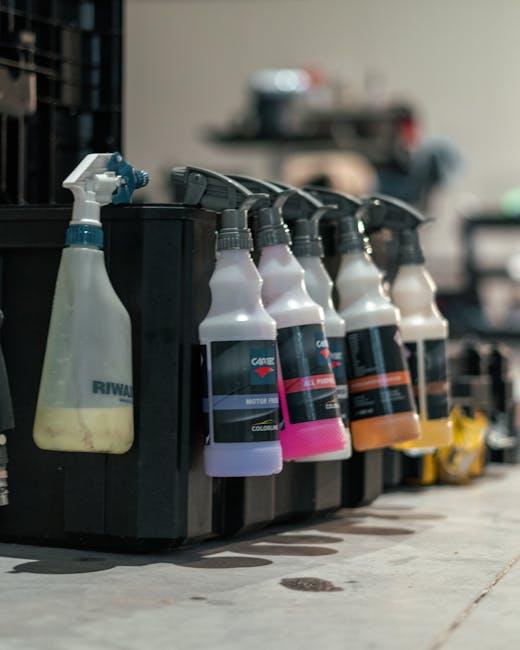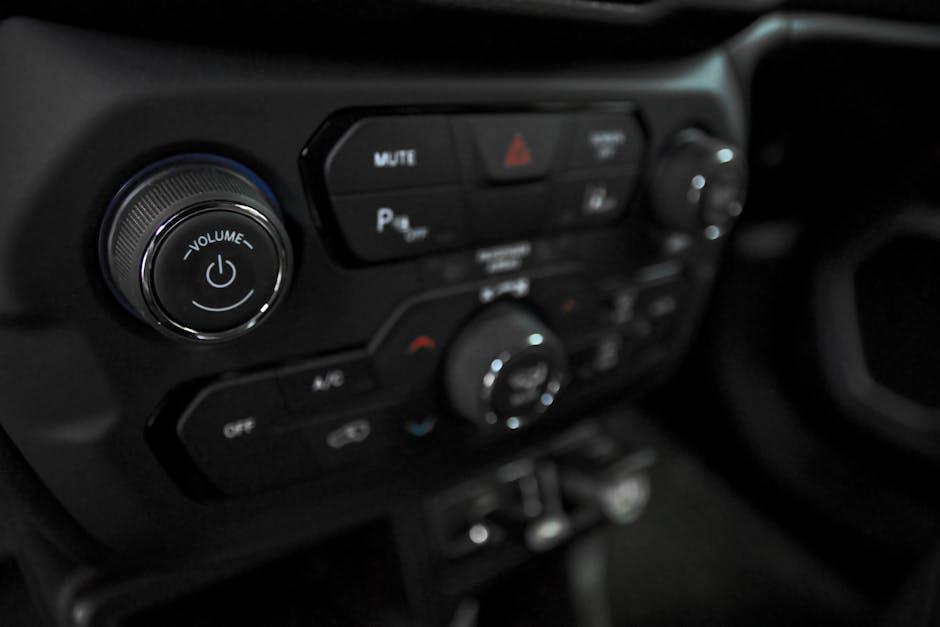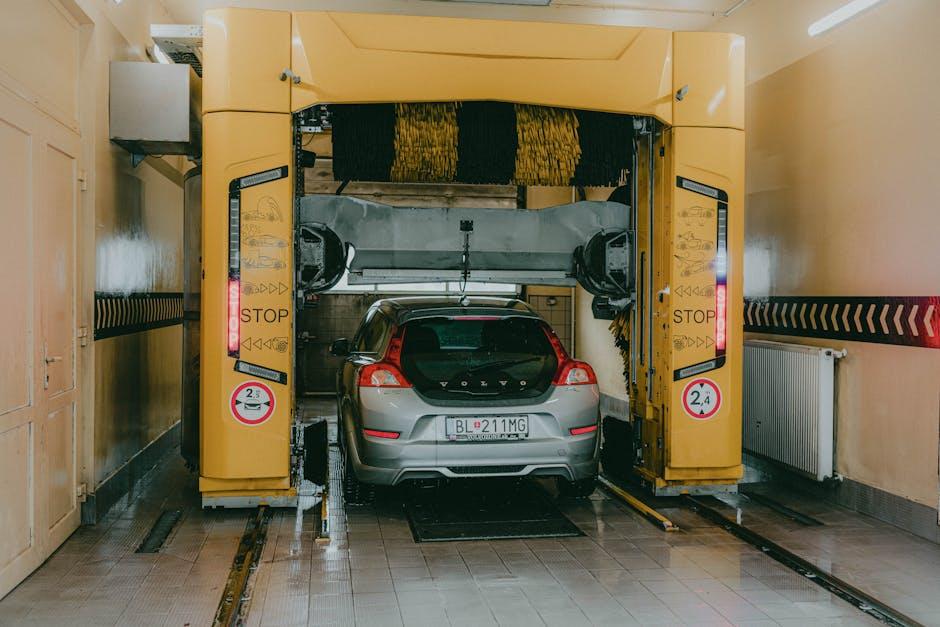When the summer heat blazes or winter’s chill sets in, your car’s air conditioning system becomes more than just a luxury—it’s essential for comfort and safety. Yet, over time, dust, mold, and accumulated debris can sneak into the vents, silently compromising the quality of the air you breathe inside your vehicle. Knowing how to clean your car’s AC system is not just about refreshing the air; it’s about maintaining a healthier environment and enhancing the efficiency of your system. In this guide, we’ll take you through practical steps to breathe new life into your car’s AC, prolong its lifespan, and keep your drives cool and comfortable all year round.
Table of Contents
- Understanding the Importance of a Clean Car AC System
- Identifying Common Signs Your Car AC Needs Cleaning
- Step-by-Step Guide to Safely Cleaning the AC Vents and Filters
- Choosing the Right Cleaning Products for Your Car AC
- Maintaining Your Car AC System for Optimal Performance
- When to Seek Professional Help for Deep AC System Cleaning
- Q&A
- Concluding Remarks

Understanding the Importance of a Clean Car AC System
Maintaining a pristine car AC system is crucial not only for comfort but also for your health and the longevity of your vehicle’s components. Over time, dust, allergens, and moisture can accumulate within the ducts and filters, creating an environment where mold and bacteria thrive. This buildup can lead to unpleasant odors, reduced airflow, and even respiratory issues for you and your passengers. By regularly cleaning your AC system, you ensure that the air circulating inside your car remains fresh and free of harmful contaminants.
Besides promoting clean air, a well-maintained AC system optimizes performance and energy efficiency, preventing unnecessary strain on your vehicle’s engine. Here’s why attention to your car’s AC cleanliness matters:
- Enhances Air Quality: Prevents mold and allergens from spreading inside the cabin.
- Prolongs System Life: Helps avoid costly repairs caused by clogged filters and dirty evaporators.
- Boosts Cooling Efficiency: Ensures maximum airflow for a cooler and more comfortable ride.
- Reduces Odors: Eliminates the musty smells caused by trapped moisture and debris.
| Component | Common Issue | Cleaning Benefit |
|---|---|---|
| Cabin Air Filter | Traps dust and pollen | Improves airflow & air purity |
| Evaporator Coil | Holds moisture & debris | Prevents mold growth |
| Air Ducts | Collect dust and bacteria | Eliminates bad odors |

Identifying Common Signs Your Car AC Needs Cleaning
When your car’s AC starts behaving unusually, it’s often a silent call for attention. Foul odors lingering even after running the system for a while are a major indicator that mold or bacteria have set up camp inside the vents or evaporator. Another common sign is a noticeable reduction in airflow, where even the highest fan setting fails to provide the refreshing breeze you expect. Coupled with this, if you find the air warmer than usual, it could mean dust and debris are clogging the filters or coils, hampering the cooling efficiency.
Pay close attention to these symptoms and the effect they have on ride comfort. Sometimes, it’s subtle cues like recurrent fogging inside the car due to excess moisture or unusual noises like rattles and hissing that reveal buildup or mechanical stress within the AC unit. To help you visualize these signs, here’s a handy table summarizing the common indicators and what they might suggest:
| Symptom | Possible Cause | Impact on AC Performance |
|---|---|---|
| Foul Odor | Mold & Bacteria Growth | Unpleasant air quality |
| Weak Airflow | Clogged Filters/Debris | Reduced cooling efficiency |
| Warm Air | Blocked Coils/Low Refrigerant | Insufficient cooling |
| Strange Noises | Mechanical Issues/Blockage | Potential system failure |

Step-by-Step Guide to Safely Cleaning the AC Vents and Filters
Begin by ensuring your car is switched off and the AC system is disengaged. Open all the vents and use a soft brush or a vacuum with a narrow nozzle to gently clear out dust and debris without pushing it deeper. For the filters, carefully remove the panel or grille protecting them, following your vehicle’s manual for exact steps. If the filter is disposable, replace it with a new one; if it’s reusable, soak it in a mild soap and water solution, then let it air dry completely before reinstalling. Always handle the filters with care to avoid tearing or damaging the delicate material.
When cleaning, use only approved, non-toxic cleaning products—especially when wiping the vents; this will prevent harmful residues from entering the cabin air. A mixture of water and white vinegar can be a natural alternative for wireless mold or mildew buildup. Check the condition of seals and surrounding ductwork during the process to address any cracks or leaks. Here’s a quick reference table for recommended cleaning intervals based on your driving environment:
| Driving Environment | Filter Cleaning Frequency | Vent Cleaning Frequency |
|---|---|---|
| Urban Areas | Every 3 months | Every 6 months |
| Rural/Dusty Areas | Every 1-2 months | Every 3 months |
| Normal/Suburban Areas | Every 4 months | Every 8 months |

Choosing the Right Cleaning Products for Your Car AC
When selecting cleaning products for your vehicle’s AC system, prioritizing safety and efficiency is key. Choose cleaners specifically formulated for automotive air conditioning units, as they balance strong antimicrobial action without damaging delicate components like evaporators and ducts. Avoid harsh chemicals such as bleach or ammonia, which can corrode metal parts or degrade rubber seals. Instead, opt for non-toxic, biodegradable options that promise both excellent cleaning power and environmental responsibility.
To help you navigate the market, keep an eye out for these product features:
- Foaming action: Expands to reach deep inside vents and evaporators.
- Anti-odor formulation: Neutralizes unpleasant smells rather than merely masking them.
- Easy application: Comes with spray nozzles or aerosol cans for user-friendly use.
| Product Type | Key Benefit | Recommended Use |
|---|---|---|
| Foaming cleaner | Deep penetration | Evaporator coil cleaning |
| Disinfectant spray | Germ elimination | Vent and duct sanitization |
| Deodorizing mist | Odor neutralization | Cabin air freshness |

Maintaining Your Car AC System for Optimal Performance
To keep your car’s air conditioning system running smoothly, regular upkeep is essential. Start by checking and replacing the cabin air filter every 12,000 to 15,000 miles, which prevents dust and debris from clogging the system. Additionally, periodically inspect the AC vents for dust buildup and clean them gently with a soft brush or compressed air. Addressing minor blockages early on helps maintain consistent airflow and reduces strain on the compressor.
Another crucial step in sustaining optimal performance is keeping the system’s refrigerant levels balanced. Low refrigerant can cause poor cooling and might even damage the AC compressor. Use a manifold gauge set or visit a professional for a refrigerant top-up if needed. Here’s a quick reference table to track common AC symptoms and their possible causes:
| Symptom | Possible Cause | Recommended Action |
|---|---|---|
| Weak airflow | Clogged filter or blocked vents | Replace filter, clean vents |
| Unpleasant odors | Mold or bacteria buildup | Use disinfectant sprays |
| Warm air | Low refrigerant | Refrigerant recharge |
- Use AC system cleaner sprays designed for automotive use to eliminate mold and bacteria inside ducts.
- Run the AC system regularly even in winter to keep seals from drying out and prevent leaks.
- Keep the condenser clean by rinsing it with water; dirt buildup reduces efficiency.

When to Seek Professional Help for Deep AC System Cleaning
While routine cleaning of your car’s AC system can be managed with everyday supplies and a little know-how, certain signs indicate it’s time to call in the experts. If you notice persistent unpleasant odors, reduced airflow, or a constant buildup of moisture inside the vents, these are red flags that require professional attention. Ignoring these symptoms can exacerbate the problem, possibly leading to costly repairs or even health issues caused by mold and bacteria growth inside the system.
Here are some scenarios when professional deep cleaning is highly recommended:
- Detected mold or mildew inside the AC ducts
- Unusual noises coming from the AC system
- Allergy-like symptoms while using the AC
- AC system hasn’t been serviced in over a year
| Issue | Professional Solution | Benefit |
|---|---|---|
| Mold Buildup | Deep sanitization and deodorizing | Improves air quality and eliminates odors |
| Blocked Vents | Thorough cleaning and vent unclogging | Restores proper airflow and cooling |
| Electrical Issues | System inspection and repair | Prevents system failure and enhances safety |
Q&A
Q&A: How to Clean Your Car’s AC System
Q1: Why is it important to clean my car’s AC system?
A1: Over time, your car’s AC system can accumulate dust, mold, and bacteria, leading to unpleasant odors and reduced air quality. Cleaning it not only refreshes the air you breathe but can also improve the system’s efficiency and prolong its lifespan.
Q2: What signs indicate my car’s AC needs a cleaning?
A2: Common signs include musty or moldy smells when the AC is on, reduced airflow, unusual noises, or visible dust and debris on vents. If you notice any of these, it’s time for a thorough cleaning.
Q3: Can I clean the AC system myself, or should I see a professional?
A3: Basic cleaning, like replacing the cabin air filter and wiping down vents, can be a DIY task. However, deep cleaning involving the evaporator or disinfecting mold may require professional attention to ensure proper handling and avoid damage.
Q4: What materials do I need for a basic DIY AC cleaning?
A4: You’ll need a new cabin air filter, soft microfiber cloths, a small brush or compressed air for vents, and an automotive AC cleaner or disinfectant spray specifically designed for vehicle use.
Q5: What’s the step-by-step process for cleaning the AC vents?
A5:
- Turn off your car’s engine and AC.
- Use a brush or compressed air to gently remove dust from air vents.
- Wipe down vent grills with a damp microfiber cloth and a mild cleaner.
- Spray an automotive-safe disinfectant into the vents (following the product instructions).
- Run the AC on high with recirculation mode for 10–15 minutes to circulate the disinfectant.
Q6: How often should I clean the AC system?
A6: Basic cleaning and cabin air filter replacement should be done every 12,000 to 15,000 miles or at least once a year. More intensive cleanings can be scheduled every 2–3 years or if you experience noticeable odor or airflow issues.
Q7: Can regular use of the AC help prevent buildup?
A7: Yes! Running the AC regularly, even in winter, helps keep moisture levels down inside the system, reducing the chance of mold and mildew growth.
Q8: Are there any common mistakes to avoid when cleaning the AC system?
A8: Avoid using harsh household cleaners or soaking electrical components. Never spray disinfectants directly on electronic controls or connectors. Also, don’t ignore the cabin air filter—it’s often the easiest fix for improving air quality.
Q9: What if my AC system smells bad even after cleaning?
A9: Persistent odors may indicate deeper issues like a clogged drain, mold in the evaporator, or coolant leaks. It’s best to consult a professional mechanic for a thorough inspection and cleaning.
Q10: Does cleaning the AC system improve fuel efficiency?
A10: While the effect is subtle, a well-maintained AC system can operate more efficiently, reducing strain on your engine and potentially improving fuel economy slightly during AC use.
Cleaning your car’s AC system doesn’t have to be a daunting chore. With regular care and simple steps, you can enjoy fresher, cleaner air and a more comfortable ride all year round.
Concluding Remarks
Keeping your car’s AC system fresh and efficient doesn’t have to be a mystery or a chore reserved for the pros. With a little care and the right steps, you can ensure every breeze feels cool, clean, and comforting—turning every drive into a breath of fresh air. So, roll down those windows, gather your tools, and give your car’s AC the attention it deserves. Your future self (and your passengers) will thank you for it.

